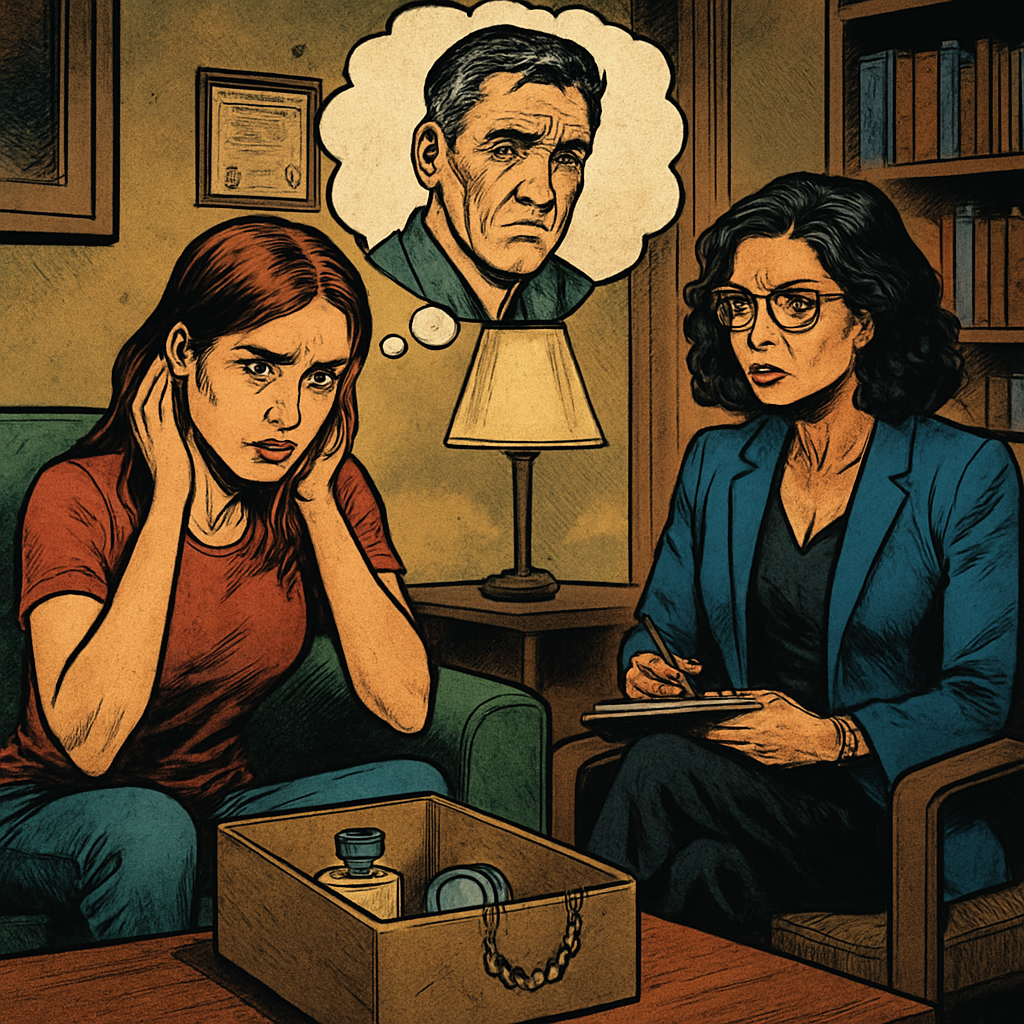🔍 The Grief That Wasn’t Allowed
I once watched a woman at a restaurant trying to cut her steak with a spoon. For fifteen minutes, she sawed away at the filet with this ridiculous utensil while a perfectly good knife sat inches from her plate. Her dining companions exchanged glances but said nothing. Finally, I couldn’t take it anymore and asked the waitress to point out the knife. “Oh,” the woman said, looking genuinely surprised, “I didn’t see that there.” Sometimes the tools we need to fix our problems are sitting right in front of us, but we’ve been trained not to see them. 🍽️
Alexis K. was that woman with the spoon, metaphorically speaking. I remember her fidgeting in my office that first session, her fingers constantly tucking and re-tucking her hair behind her ears exactly seven times whenever she felt anxious – a quirk that became our private barometer for her stress levels. She came to me after her mother had reached out wanting family therapy to repair their estrangement. “I should want this, right?” she asked. “I mean, everyone says you only get one mother.”
The heart of Alexis’s story wasn’t just about estrangement – it was about emotional invisibility. Her father died before she was born, and when her mother remarried, her stepfather essentially outlawed any mention of her biological father. This wasn’t just about jealousy; it was about emotional bytes being forcibly deleted from the family’s operating system.
During our third session, Alexis revealed something that explained everything: “I keep a box of my dad’s things hidden in my closet. Sometimes I take it out and just… touch his watch or smell his cologne. My stepfather found it once when I was sixteen and threw everything in the trash. I dug it all out that night while everyone was sleeping. My mom knows I have it, but we pretend she doesn’t.” 💔
📝 The Invisible Family Scripts
What’s fascinating about family estrangements is how rarely they’re about what people think they’re about. Research consistently shows they’re not typically the result of one dramatic betrayal, but rather the cumulative effect of emotional invalidation – the constant tiny paper cuts to the psyche that eventually create an unbridgeable wound.
Every family operates with unspoken rules – invisible structures that dictate what emotions are acceptable and which must be suppressed. In Alexis’s case, the structure was rigid: grief for her father was forbidden territory. This created an impossible emotional script for her to follow – deny a core part of her identity or face rejection.
“You know what still gets me?” Alexis told me once. “For my sixteenth birthday, my aunt gave me a necklace with my dad’s birthstone. I was so happy I cried. My mom took me aside later and asked me to only wear it when we weren’t around my stepfather. I threw it in a drawer and haven’t worn it since.”
Studies show that these moments of having to choose between authentic expression and family acceptance create profound identity conflicts. When your emotions become a family secret, you learn to distrust your own internal signals. ⚖️
🎭 The Meta-Emotional Failure
What struck me most about Alexis’s situation was the profound meta-emotional failure at play. Her mother couldn’t tolerate her own complicated feelings about her late husband, so she outsourced that emotional regulation to her new husband’s preferences. This created a cascade effect where everyone’s emotional needs went underground – expressed through tension, distance, and eventually estrangement, rather than words.
When I asked Alexis if she wanted to try therapy with her mother, she revealed a remarkable insight: “I don’t actually need her to talk about my dad anymore. I needed that when I was nine. What I need now is for her to acknowledge that she made me choose between having a relationship with my dead father or with her. And I need to know if that’s still the choice she’s offering.”
This is the crucial distinction many miss in family healing – it’s rarely about the original wound anymore. It’s about whether the person who inflicted it can take responsibility for the impact without making their apology contingent on getting something in return.
🌅 When Healing Means Setting Terms
The mother’s request for therapy wasn’t wrong – but her framing of “not wanting to lose” Alexis revealed she was still focused on her own needs rather than understanding the depth of her daughter’s experience.
Family estrangements don’t heal through proximity; they heal through perspective. Sometimes the most loving thing we can do is acknowledge that not all relationships can or should be repaired on the timeline we might wish for.
💡 Core Insight: The ghosts we refuse to acknowledge don’t disappear; they simply haunt the spaces between our words.
Wondering if I ever recommended that family therapy session? That’s between Alexis and me. But I will say this: sometimes the bravest thing isn’t reconciliation – it’s having the courage to set the terms under which reconciliation might one day be possible. 🌱
Stubbornly refusing to recommend meditation since 1998,
Sophia Rivera
—
https://pmc.ncbi.nlm.nih.gov/articles/PMC4507819/
https://www.talkspace.com/blog/estranged-adult-children/
https://digitalcommons.unl.edu/cgi/viewcontent.cgi?article=1066&context=commstudiespapers
https://www.youtube.com/watch?v=g55G_f7jqjU
https://www.finebergpsychotherapy.com/parent-adult-child-estrangement
https://www.apa.org/monitor/2024/04/healing-pain-estrangement

